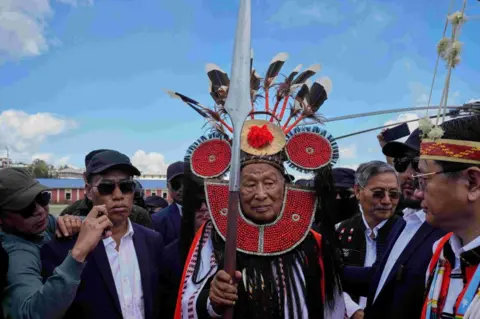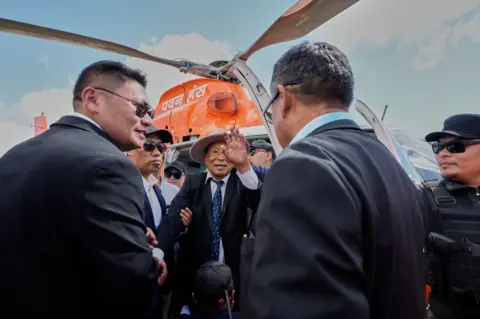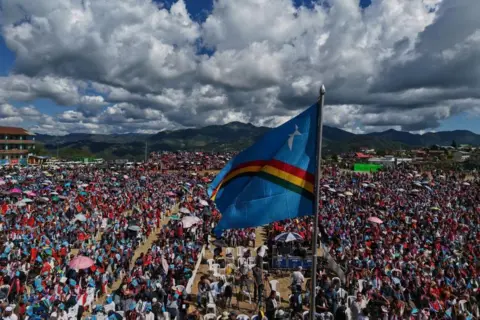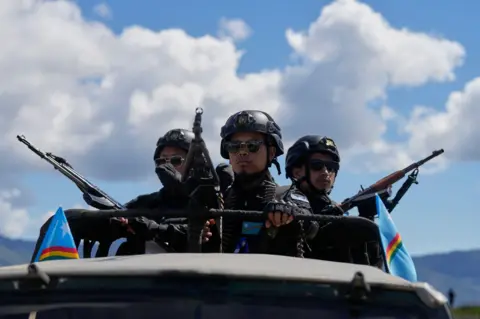Soutik BiswasIndia correspondent
 AP
APLast week, a helicopter appeared over the green, folded hills of Ukhrul in India’s north-eastern state of Manipur.
By the time it touched down on a makeshift helipad outside Somdal village, the crowd had already begun to sing. When the door opened, the crowd surged towards a frail man in dark glasses and a black suit. Quickly, they draped him in a traditional shawl.
After more than half a century, Thuingaleng Muivah, India’s oldest rebel, had come home.
Now 91, Mr Muivah is the general secretary of the National Socialist Council of Nagalim (Isak-Muivah), or NSCN (I-M), the most powerful of the Naga insurgent factions that once fought the Indian state in one of Asia’s longest-running rebellions – though today the organisation is often regarded as a shadow of its former self.
His supporters see him as the keeper of a demand India has never recognised – a separate state for Naga people. His critics remember something else: a movement accused of targeted killings and running a parallel government in Nagaland through “taxes” many call extortion – allegations the NSCN (I-M) denies.
Nagaland, a largely Christian state wedged between Myanmar and Bangladesh, is home to a people spread across neighbouring Manipur, Arunachal Pradesh and Assam states. Muivah seeks either full sovereignty or a “Greater Nagaland” uniting Nagas across borders, especially in Manipur.
Muivah himself was born in Manipur – a reminder that the Naga identity extends far beyond Nagaland’s borders.
This was his second attempt to return home – the first, in 2010, was blocked by the Manipur government, which cited the risk of unrest and security concerns. When he finally made it back with his wife last week, almost the entire village gathered to welcome the Avakharar – the “eldest father”, as they called him. Among them was his only surviving sibling, 84-year-old Asui Muivah.
“Generation comes and goes, but the nation stays,” he wrote in a message read aloud by his deputy, VS Atem, as he was too weak to speak himself. “The issue we are fighting for is greater and older than most of us.”
 AP
APMuivah had left this same hillside village in 1964, trekking east to join the Naga struggle for sovereignty – a journey that would take him to the jungles of northern Myanmar, the ideological camps of Maoist China and the negotiation tables of Delhi.
After coming out of the jungles for a ceasefire in 1997, Muivah has lived in Delhi and a sprawling camp in Hebron in Nagaland, which serves as the NSCN (I-M)’s headquarters, complete with signs declaring, “Freedom is the birthright of all nations”.
“His return to his village is more personal than political – driven by a longing for home. His calls for a separate Naga flag and a constitution are expected, and they help keep him politically relevant. But the broader idea of ‘Greater Nagaland’ has largely faded over the years,” says Pradip Phanjoubam, editor-in-chief of the Imphal Review of Arts and Politics.
The Naga struggle predates India itself. In 1918, returning World War One labourers formed the Naga Club to assert a distinct identity. When India became independent in 1947, Naga leaders refused to join the new republic, declaring, “We are not Indians”, and held their own unrecognised plebiscite for independence in 1951.
As armed conflict began to intensify, the Indian government sent in troops in 1955. What followed was decades of insurgency, factional splits and ceasefires. The rebellion claimed thousands of lives, displaced generations and militarised the lush, Christian-majority hills.
“The Naga conflict,” says political scientist Sanjib Baruah, “is among the world’s least-known but longest-running armed movements.”
Muivah was born in March 1935 in Somdal, where his family often went hungry. Educated at a local Christian school, he was drawn early to the ideas of revolution and Naga nationalism.
By his teens, Muivah was already a Naga nationalist, singing “God Bless My Nagaland” at school and questioning why his people lived in “humiliation” under the colonial government. After studying at St Anthony’s College in Shillong and reading Marx, Hegel and Rousseau, he joined the Naga National Council (NNC) – the first political organisation of the Nagas to demand independence from India – in 1964.
 AP
APTwo years later, 31-year-old Muivah joined more than 130 guerrillas on a 97-day trek through the jungles of northern Myanmar to China’s Yunnan province. “We carried our own rice and slept on grass in clearings,” he said in a 1998 interview. “I could stand the hunger, but sometimes there was no water to drink.” They crossed rivers on bamboo rafts hacked through thick undergrowth, and trudged on in subzero cold.
Beijing trained the rebels in guerrilla warfare, Marxist-Leninist theory and “people’s war”. Muivah studied briefly in Beijing’s College of Diplomacy, visited Vietnam and came back speaking reverently of Mao and Zhou Enlai – though he would later fuse their ideology with a deeply Christian nationalism. He returned to Nagaland after five years.
In 1980, Muivah and his comrades Isak Chishi Swu and SS Khaplang founded the NSCN, breaking away from the older NNC that had signed a controversial peace accord with Delhi.
Their faction later split again – into the NSCN (I-M) and NSCN (K), led by Khaplang of Myanmar – spawning smaller offshoots across the northeast.
At its height, the NSCN (I-M) was the mother of all insurgencies in the region, training and arming smaller ethnic groups and running what India’s intelligence agencies called a “shadow state” across the hills, according to Subir Bhaumik, a veteran chronicler of the region. The group faced accusations of extortion, killings and human rights abuses.
Critics within the Naga insurgency also point to a violent legacy. The Zeliangrong United Front (ZUF) has accused Muivah of ordering “merciless killings of many prominent leaders” and carrying out arson in villages “in the name of taxation or fighting the Indian Army,” leaving “common Nagas” to bear the cost, its spokesperson Louis Gangmei said.
Over the years, Muivah transformed from jungle commissar to political negotiator. After decades of exile – in Thailand, the Netherlands and the borderlands of Myanmar – he entered a ceasefire with India.
But his demand for a separate Naga flag and constitution remains a stumbling block. In a interview in 2020, Muivah told journalist Karan Thapar: “The Nagas will never be part of the Indian Union, nor accept its constitution. There can be no solution without our flag and our constitution.”
The Indian government has offered greater autonomy, but rejects any concession implying sovereignty; the 2015 Framework Agreement, once hailed as a breakthrough, now languishes. “We have not surrendered our free existence and sovereignty ,” Muivah declared last week. “Come what may, we shall defend it to the last.”
 AP
APYet over the past decade, as Muivah’s health declined and the movement splintered into dozens of factions, the NSCN (I-M)’s once-formidable influence has waned. A younger generation of Nagas, weary of blockades and extortion, now increasingly seeks peace and economic stability.
At the same time, experts like Prof Baruah say that the “proud display of Naga flags in his home village testifies to the vitality and resilience of the Naga movement” – a reminder that while its horizons may have narrowed, the sentiment endures.
More importantly, he adds, “even objectively strong states can choose live-and-let-live deals with armed groups rather than trying to disarm and demobilise them”.
Muivah says his group has held more than 600 rounds of talks with New Delhi on a Naga homeland since the late 1990s. Yet critics remain unsparing. The Manipur-based ZUF dismissed his return as “empty-handed,” arguing there is “no reason to glorify an individual who failed the Nagas on all fronts.” Supporters believe he is war-weary, unsure of peace, and still waiting for the political settlement that has defined his life’s struggle.
As early as 2006, he told Mr Bhaumik, the journalist, “I am very tired. I feel doubly tired because there seems to be no result coming out of the talks.” The wait goes on.
Additional reporting by Abhishek Dey
